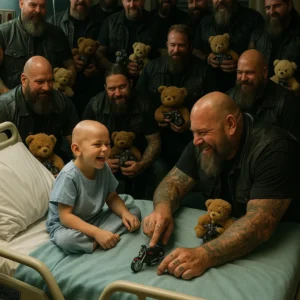My niece moved in after her mom entered rehab—quiet girl, always scribbling in her notebook. One evening, I peeked inside while tidying her room. The pages were filled with drawings of a woman locked in a closet. I asked gently, “Is this your mom?” She stared at me, then whispered, “No… that’s you.” I laughed—until I turned to the last page and saw myself drawn with my eyes crossed out, and a date written underneath. That date was tomorrow.
I’m not someone who spooks easily. I’ve worked in emergency nursing for almost two decades. I’ve seen life at its messiest—blood, heartbreak, full-blown psychotic breaks. But something about that drawing… it got under my skin. It wasn’t just the image. It was the precision. She’d drawn the mole under my chin, the pattern on my favorite cardigan, even the tiny chip on my front tooth.
I didn’t say anything that night. Just kissed her forehead, wished her goodnight, and went to bed with a stomach full of unease. That was the first night I locked my bedroom door since moving into that house six years ago.
Let me back up.
My niece, Safiya, came to live with me three weeks ago. Her mom—my younger sister Laleh—had finally agreed to enter treatment after years of struggling with meth and prescription pills. The arrangement wasn’t sudden, but the change in our house was. Safiya was 12, but looked 10. Small for her age, with this haunted stare like she’d already seen too much. She didn’t talk much. Just drew.
She carried that notebook like it was a part of her body. Always clutching it under her arm or curling around it like a cat when she slept. I respected her privacy. Until that night.
After seeing that final page, I started noticing things.
Little details I’d brushed off before, but now they stuck. Like the time I found a spoon jammed into the bathroom door’s lock. She said it was “just playing spies.” Or how she’d sometimes sit for hours staring at the attic hatch in the hallway, as if waiting for something—or someone—to come down. The drawings grew more vivid. More… knowing.
One morning I found a new sketch left on the kitchen table. It showed me, asleep in my bed, and someone standing over me with a pair of scissors. The person had no face. Just a dark blur where the features should’ve been. Safiya was already at school, so I texted her a simple question: “Did you draw this?”
She replied right away. “It wasn’t me. But I think I know who did.”
That’s when I stopped brushing things off.
I took the day off work and went into full investigator mode. Started with her room. I went through drawers, under the bed, inside her backpack. I didn’t really know what I was looking for—evidence of trauma? A clue? All I found were crumpled receipts, some candy wrappers, and, tucked in the back of her closet, a second notebook. This one older, with a cracked leather cover.
It wasn’t full of drawings. It was full of notes.
Rambling, jittery handwriting, all in Safiya’s style. Things like “don’t tell her when the woman cries through the vents” and “ask grandma about the crawlspace door” and “the woman in the mirror isn’t dead if you don’t forget her name.” Page after page. Disturbing, but also sad. Like she’d been trying to process something no one was helping her understand.
When she got home that evening, I sat her down and asked her straight. “Sweetheart, I want you to feel safe here. But I need you to tell me—what do these drawings mean?”
She didn’t answer right away. She just looked at me, then looked past me, toward the hallway.
“I think she wants to come out,” she whispered. “She doesn’t like you here.”
“Who?”
“The other auntie.”
I stared at her. “Safiya… you don’t have another aunt. It’s just me.”
She shook her head, firm. “Not by blood. She lived here before you. In the walls.”
Okay. At that point, I’m thinking—trauma, maybe psychosis. A kid acting out years of instability, making up stories to deal with stress. I did what any adult in my shoes would do. I called a child psychologist the next morning and set up an evaluation.
But then the neighbor said something that made my stomach twist.
Mrs. Demsky lives two doors down. She’s been on the block since the ’80s. I was taking the trash bins out when she waved me over, casually asked how I was adjusting to having a child around.
Then she said, “Funny, I never thought they’d let someone live in that house again after what happened.”
I paused. “What do you mean?”
“Oh, you know, the woman who used to live there. The artist. The one who went missing.”
Apparently, a woman named Avigail rented my house five years before I bought it. She was quiet, eccentric. No close family. She’d just stopped showing up to her pottery studio one week. Mail piled up. No signs of struggle, but she was gone. Police looked, didn’t find much. The case fizzled. Everyone assumed she’d run off or met someone and disappeared on purpose.
But the timing made me dizzy. Five years before I moved in. And according to the notes in Safiya’s second notebook… that’s exactly how long the “other auntie” had been “whispering from the vents.”
Still, I’m a practical woman. I don’t believe in ghosts. But I do believe in secrets hiding in plain sight.
So I called my cousin Bahram, who does contracting, and asked him to help me inspect the crawlspace under the house. We pulled back the panel in the coat closet and shimmied in. There wasn’t much—old insulation, spider webs, a few discarded wrappers. But behind one wall, we found a sealed section. Sheetrock nailed over a frame that clearly didn’t belong.
We pried it open.
Inside was a narrow compartment. And in it… were canvases. Dozens. All painted in the same style—abstract, chaotic, mostly in greys and reds. And in the corner, under a stained tarp, was a ceramic sculpture of a woman. Life-sized. Arms crossed. Eyes wide open.
I couldn’t stop shaking.
Later that week, a detective came by. Turns out, the woman who went missing was named Avigail Dagan, and yes, she’d been reported missing. The sculpture was sent to the lab. DNA confirmed that the clay she used had been mixed with human remains—hers.
My knees nearly buckled when they told me.
But here’s the thing that shook me the most: on the bottom of the sculpture, etched in faint cursive, were the words: “She wouldn’t leave. So I stayed instead.”
They never found out exactly what happened to her. No arrests. No clear evidence of foul play beyond the obvious. But the case was reopened, and suddenly all the odd things in my house made sense.
Safiya wasn’t imagining anything. She’d been picking up on something I hadn’t. Whether it was emotional residue, or something else—I still don’t know.
But here’s the twist that still gives me chills.
After the sculpture was removed and the crawlspace cleaned out, Safiya stopped drawing the locked closet woman. Completely. But she started drawing something else: bright rooms. Open doors. Sunflowers.
One day she handed me a picture of the two of us on a porch swing, her head on my shoulder. In the corner, she’d scribbled: “No one in the walls anymore.”
When I asked her why she wrote that, she said, “Because you saw her. And she let go.”
To this day, I don’t know what exactly Safiya experienced. Maybe the house carried an imprint. Maybe her mom had told her cryptic stories before rehab. Or maybe—maybe trauma and truth sometimes look the same when you’re twelve.
But what I do know is this: when we’re willing to listen to the quietest voices—the children, the ones dismissed, the ones drawing strange pictures at dinner tables—we find the missing pieces.
Sometimes healing doesn’t look like medicine. Sometimes, it’s a locked door opened, a secret pulled into the light, and a kid finally drawing sunflowers instead of shadows.
So yeah, I keep that last drawing on the fridge now. And I don’t lock my bedroom door anymore.
Not because I’m not afraid. But because I finally understand what we were afraid of.
If you read this far, thanks. And if you’ve got a kid in your life who keeps drawing the same strange thing over and over—ask them about it. Really ask.
You might be the only one who does.
Like and share if you believe kids see more than we think.





